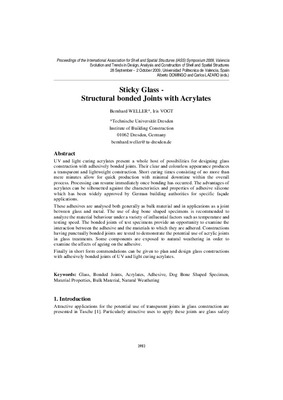JavaScript is disabled for your browser. Some features of this site may not work without it.
Buscar en RiuNet
Listar
Mi cuenta
Estadísticas
Ayuda RiuNet
Admin. UPV
Sticky Glass - Structural bonded joints with acrylates
Mostrar el registro sencillo del ítem
Ficheros en el ítem
| dc.contributor.author | WELLER, Bernhard
|
|
| dc.contributor.author | VOGT, Iris
|
|
| dc.contributor.editor | Domingo Cabo, Alberto
|
es_ES |
| dc.contributor.editor | Lázaro Fernández, Carlos Manuel
|
es_ES |
| dc.date.accessioned | 2009-12-18T10:50:48Z | |
| dc.date.available | 2009-12-18T10:50:48Z | |
| dc.date.issued | 2009-12-18T10:50:48Z | |
| dc.identifier.isbn | 978-84-8363-461-5 | |
| dc.identifier.uri | http://hdl.handle.net/10251/6703 | |
| dc.description | p. 2982-2989 | en_EN |
| dc.description.abstract | UV and light curing acrylates present a whole host of possibilities for designing glass construction with adhesively bonded joints. Their clear and colourless appearance produces a transparent and lightweight construction. Short curing times consisting of no more than mere minutes allow for quick production with minimal downtime within the overall process. Processing can resume immediately once bonding has occurred. The advantages of acrylates can be silhouetted against the characteristics and properties of adhesive silicone which has been widely approved by German building authorities for specific façade applications. These adhesives are analysed both generally as bulk material and in applications as a joint between glass and metal. The use of dog bone shaped specimens is recommended to analyze the material behaviour under a variety of influential factors such as temperature and testing speed. The bonded joints of test specimens provide an opportunity to examine the interaction between the adhesive and the materials to which they are adhered. Constructions having punctually bonded joints are tested to demonstrate the potential use of acrylic joints in glass treatments. Some components are exposed to natural weathering in order to examine the affects of ageing on the adhesive. Finally in short form commendations can be given to plan and design glass constructions with adhesively bonded joints of UV and light curing acrylates. | en_EN |
| dc.language | Inglés | en_EN |
| dc.publisher | Editorial Universitat Politècnica de València | es_ES |
| dc.relation.ispartof | Symposium of the International Association for Shell and Spatial Structures (50th. 2009. Valencia). Evolution and Trends in Design, Analysis and Construction of Shell and Spatial Structures : Proceedings | en_EN |
| dc.rights | Reserva de todos los derechos | en_EN |
| dc.subject | Glass | en_EN |
| dc.subject | Bonded joints | en_EN |
| dc.subject | Acrylates | en_EN |
| dc.subject | Adhesive | en_EN |
| dc.subject | Dog bone shaped specimen | en_EN |
| dc.subject | Material properties | en_EN |
| dc.subject | Bulk material | en_EN |
| dc.subject | Natural weathering | en_EN |
| dc.title | Sticky Glass - Structural bonded joints with acrylates | en_EN |
| dc.type | Comunicación en congreso | en_EN |
| dc.rights.accessRights | Abierto | es_ES |
| dc.description.bibliographicCitation | Weller, B.; Vogt, I. (2009). Sticky Glass - Structural bonded joints with acrylates. Editorial Universitat Politècnica de València. http://hdl.handle.net/10251/6703 | es_ES |
| dc.relation.conferencename | Symposium of the International Association for Shell and Spatial Structures | es_ES |
| dc.relation.conferencedate | 2009 | es_ES |
| dc.relation.conferenceplace | Valencia | es_ES |






